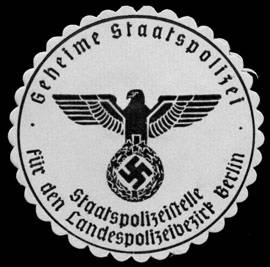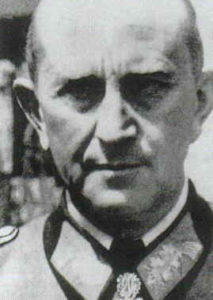Sievers, Wolfram Heinrich Friedrich, born 10-07-1905 in Hildesheim, 
 the son of a protestant church musician and organist, Heinrich Sievers (1879–1927) and his wife Elisabeth born Fischer (1839–1923). It is reported that he was musically gifted also, that he played the harpsichord, organ, and piano, and loved German baroque music. He was expelled from school for being active in the Deutschvölkischer Schutz und Trutzbund
the son of a protestant church musician and organist, Heinrich Sievers (1879–1927) and his wife Elisabeth born Fischer (1839–1923). It is reported that he was musically gifted also, that he played the harpsichord, organ, and piano, and loved German baroque music. He was expelled from school for being active in the Deutschvölkischer Schutz und Trutzbund  and went on to study history, philosophy, and religious studies at Stuttgart’s Technical University while working as a salesman. A member of the Bündische Jugend. Sievers joined the NSDAP
and went on to study history, philosophy, and religious studies at Stuttgart’s Technical University while working as a salesman. A member of the Bündische Jugend. Sievers joined the NSDAP  in 1929. In 1933 he headed up the “Externsteine Foundation”, which had been founded by SS Reichsfùhrer Heinrich Himmler.
in 1929. In 1933 he headed up the “Externsteine Foundation”, which had been founded by SS Reichsfùhrer Heinrich Himmler.



 He to study the Externsteine in the Teutoburger Wald.
He to study the Externsteine in the Teutoburger Wald.  In 1935, having joined the SS
In 1935, having joined the SS  that year, Sievers was appointed Reichsgeschäftsführer, or General Secretary, of the Ahnenerbe, by Himmler. He
that year, Sievers was appointed Reichsgeschäftsführer, or General Secretary, of the Ahnenerbe, by Himmler. He  was the actual director of Ahnenerbe operations and was to rise to the rank of SS-Standartenführer
was the actual director of Ahnenerbe operations and was to rise to the rank of SS-Standartenführer 
 He also assisted in assembling a collection of skulls and skeletons for August Hirt’s
He also assisted in assembling a collection of skulls and skeletons for August Hirt’s  study at the Reichsuniversität Strassburg as a part of which 112 Jewish prisoners were selected and killed, after being photographed and their anthropological measurements taken. August Hirt (28-04-1898 – 02-06-1945) was an anatomist with Swiss and German nationality who served as a chairman at the Reich University in Strasbourg during World War II. He performed experiments with mustard gas on inmates at the Natzweiler-Struthof concentration camp and played a lead role in the murders of 86 people at Natzweiler-Struthof for the Jewish skeleton collection.
study at the Reichsuniversität Strassburg as a part of which 112 Jewish prisoners were selected and killed, after being photographed and their anthropological measurements taken. August Hirt (28-04-1898 – 02-06-1945) was an anatomist with Swiss and German nationality who served as a chairman at the Reich University in Strasbourg during World War II. He performed experiments with mustard gas on inmates at the Natzweiler-Struthof concentration camp and played a lead role in the murders of 86 people at Natzweiler-Struthof for the Jewish skeleton collection.  The skeletons of his victims were meant to become specimens at the Institute of anatomy in Strasbourg, but completion of the project was stopped by the progress of the war. He was an SS-Hauptsturmführer (captain) and in 1944, an SS-Sturmbannführer (major).
The skeletons of his victims were meant to become specimens at the Institute of anatomy in Strasbourg, but completion of the project was stopped by the progress of the war. He was an SS-Hauptsturmführer (captain) and in 1944, an SS-Sturmbannführer (major).Sievers was tried during the Doctor’s Trial at Nuremberg

 following the end of World War II, where he was dubbed “the Nazi Bluebeard” by journalist William Shirer because of his “thick, ink-black beard”. As the Institute for Military Scientific Research had been set up as part of the Ahnenerbe, the prosecution at Nuremberg laid the responsibility for the experiments on humans which had been conducted under its auspices on the Ahnenerbe and Sievers, as its highest administrative officer, was accused of actively aiding and promoting the criminal experiments. Sievers was charged with being a member of an organization declared criminal by the International Military Tribunal, the SS, and was implicated in the commission of war crimes and crimes against humanity. In his defense, he alleged that as early as 1933, he had been a member of an anti-Nazi resistance movement which planned to assassinate Adolf Hitler (see Alois Hitler) and Himmler, and that he had obtained his appointment as Manager of the Ahnenerbe so as to get close to Himmler and observe his movements. He further claimed that he remained in the post on the advice of his resistance leader to gather vital information which would assist in the overthrow of the Nazi regime.
following the end of World War II, where he was dubbed “the Nazi Bluebeard” by journalist William Shirer because of his “thick, ink-black beard”. As the Institute for Military Scientific Research had been set up as part of the Ahnenerbe, the prosecution at Nuremberg laid the responsibility for the experiments on humans which had been conducted under its auspices on the Ahnenerbe and Sievers, as its highest administrative officer, was accused of actively aiding and promoting the criminal experiments. Sievers was charged with being a member of an organization declared criminal by the International Military Tribunal, the SS, and was implicated in the commission of war crimes and crimes against humanity. In his defense, he alleged that as early as 1933, he had been a member of an anti-Nazi resistance movement which planned to assassinate Adolf Hitler (see Alois Hitler) and Himmler, and that he had obtained his appointment as Manager of the Ahnenerbe so as to get close to Himmler and observe his movements. He further claimed that he remained in the post on the advice of his resistance leader to gather vital information which would assist in the overthrow of the Nazi regime.Death and burial ground of Sievers, Wolfram Heinrich Friedrich .


Sievers was sentenced to death on 20-08-1947 for crimes against humanity and hanged on 02-06-1948, age 42, at Landsberg prison in Bavaria. 







He is buried on the Landsberg Prison Spöttinger Cemetery next to other hanged war criminals, SS Standartenführer, Adjudant from Reichsführer Himmler, Rudolf Brandt, SS Obergruppenführer, Gauleiter and Reichsstatthalter (Reich Governor) of Mecklenburg, Karl Hildebrandt, SS Hauptscharfführer, head of the Crematoria of Auschwitz, Otto Moll,  SS Brigadeführer, Kommandant of Einsatzgruppe B, Erich Naumann, the organiser of the Euthanasia Programme, Action T4, Victor Brack, and SS Obergruppenführer, Oswald Pohl.
SS Brigadeführer, Kommandant of Einsatzgruppe B, Erich Naumann, the organiser of the Euthanasia Programme, Action T4, Victor Brack, and SS Obergruppenführer, Oswald Pohl.
 SS Brigadeführer, Kommandant of Einsatzgruppe B, Erich Naumann, the organiser of the Euthanasia Programme, Action T4, Victor Brack, and SS Obergruppenführer, Oswald Pohl.
SS Brigadeführer, Kommandant of Einsatzgruppe B, Erich Naumann, the organiser of the Euthanasia Programme, Action T4, Victor Brack, and SS Obergruppenführer, Oswald Pohl.
 All the bronze plates are removed from the crosses now, as the population of Landsberg protested against the mixed graveyard with murders and their victims.
All the bronze plates are removed from the crosses now, as the population of Landsberg protested against the mixed graveyard with murders and their victims.

Message(s) for the webmaster, tips or interesting graves: robhopmans@outlook.com























Leave a Reply